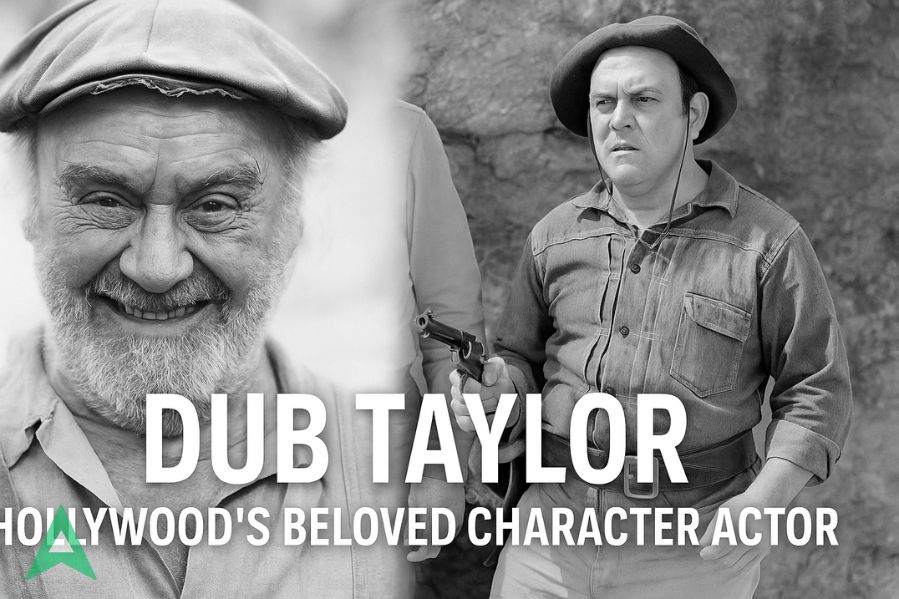Dub Taylor: Hollywood’s Beloved Character Actor

Dub Taylor may not have always played the leading man, but his career in Hollywood made him one of the most recognizable and beloved character actors of the 20th century. From his memorable roles in classic Westerns to his comedic appearances in film and television, Taylor built a legacy of versatility, charm, and reliability. This article explores his early life, career highlights, personal anecdotes, and lasting influence on American cinema.
Table of Contents
Quick Bio
| Category | Details |
|---|---|
| Full Name | Walter Clarence “Dub” Taylor Jr. |
| Nickname | Dub |
| Birth Date | February 26, 1907 |
| Death Date | October 3, 1994 |
| Profession | Actor, Musician |
| Famous For | Western films, television roles |
| Notable Films | The Wild Bunch, Gremlins, Back to the Future Part III |
| Legacy | Hollywood’s go-to character actor in Westerns |
Early Life and Background
- Full Name: Walter Clarence “Dub” Taylor Jr.
- Born: February 26, 1907 – Richmond, Virginia, USA
- Died: October 3, 1994 – Los Angeles, California, USA
- Occupation: Actor (film, television, theater)
- Specialty: Character acting, Western genre roles
Dub Taylor’s journey began in the American South. Nicknamed “Dub” from the phonetic sound of “W” in Walter, he grew up with a love for performance and music. Before becoming an actor, he was a skilled musician who played the xylophone—a talent that helped him break into show business.
Career Beginnings in Hollywood
Taylor’s first notable role came in “You Can’t Take It with You” (1938), a Frank Capra classic that won the Academy Award for Best Picture. His natural comic timing and expressive personality quickly caught the attention of directors. Soon after, he became a staple in Westerns, where his friendly, down-to-earth demeanor fit perfectly into the rugged landscapes of American cinema.
Rise in the Western Genre
Dub Taylor’s association with Westerns became the cornerstone of his career. Appearing in dozens of films alongside legendary actors, he often played humorous sidekicks, townsfolk, or quirky supporting characters that brought heart to the story.
Notable Western Appearances:
- “Bonanza” (TV Series) – Multiple guest roles
- “Gunsmoke” (TV Series) – Frequent appearances over two decades
- “Maverick” – Classic TV Western episodes
- “The Wild Bunch” (1969) – A gritty Sam Peckinpah masterpiece
- “Back to the Future Part III” (1990) – Memorable cameo role
His work in The Wild Bunch stands out as one of his most iconic film appearances, where he played the role of a card dealer—small but unforgettable in the gritty Western epic.
Expanding Beyond Westerns
Although Westerns defined much of his career, Dub Taylor also appeared in comedies, dramas, and even family-friendly films. His versatility allowed him to fit seamlessly into various genres.
Other Popular Films:
- “The Getaway” (1972) – Crime thriller directed by Sam Peckinpah
- “Thunderbolt and Lightfoot” (1974) – Starring Clint Eastwood and Jeff Bridges
- “Gremlins” (1984) – Quirky role in the cult-classic fantasy film
- “Maverick” (1994) – Final film role before his passing
Taylor’s ability to shift from comedic relief to serious supporting roles made him a dependable presence for filmmakers seeking authenticity.
Personality and Screen Presence
Dub Taylor was admired not just for his roles but for his approachable and friendly demeanor off-screen. Directors appreciated his reliability, and audiences loved his ability to make even the smallest parts shine. His Southern charm and comedic timing made him a natural fit in almost any project.
Legacy in Hollywood
Dub Taylor’s impact is often understated, but his longevity in the industry—spanning more than five decades—is a testament to his talent and adaptability. He worked with some of the greatest directors and actors in Hollywood, from Frank Capra to Clint Eastwood, leaving behind a vast filmography that continues to entertain audiences.
His children also carried on his artistic spirit. His son, Buck Taylor, became a well-known actor in his own right, notably for his role in Gunsmoke.
Interesting Facts About Dub Taylor
- He was an accomplished xylophone player, which helped him land early entertainment jobs.
- He often played barbers, bartenders, or sidekicks in Westerns, becoming almost typecast but beloved for these roles.
- Despite appearing in hundreds of films and TV episodes, he remained humble and grateful for steady work in Hollywood.
- His final film role was in “Maverick” (1994), released the same year as his passing.
For more on Western film history and classic cinema, visit American Film Institute.
Conclusion
Dub Taylor may never have been the headline star, but he embodied what it meant to be a true character actor. His work spanned decades, genres, and generations, leaving behind a legacy of authenticity, humor, and heart. Whether in gritty Westerns, comedies, or fantasy films, Taylor brought life to every role he touched.
People Read Also: Miguel Leon Tyson: Everything About Mike Tyson’s Son
(FAQs)
1. Was Dub Taylor a real cowboy?
No, but his authentic Southern roots and mannerisms made him a convincing figure in Westerns.
2. What was Dub Taylor’s first movie?
He debuted in “You Can’t Take It with You” (1938).
3. Did Dub Taylor have children in Hollywood?
Yes, his son Buck Taylor became a successful actor.
4. How many movies did Dub Taylor appear in?
He appeared in over 200 films and TV shows throughout his career.
5. What was his final movie role?
His last film role was in “Maverick” (1994).
Disclaimer:
This article is intended for informational and educational purposes only. It is based on publicly available information, biographical data, and historical records about Dub Taylor and his career. While every effort has been made to ensure accuracy, there may be unintentional errors or omissions. The content does not claim to represent official statements from Dub Taylor’s estate, family, or affiliated organizations. Any references to films, television shows, or external sources are used strictly for commentary, research, and informational purposes under fair use. Readers are encouraged to consult verified sources and archives for further detailed information.



